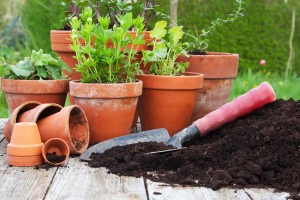 The difference between cooking and baking is spontaneous creativity—well, at least with measurement and ingredients. Baking is an exact science—not enough or too much flour or making the mistake of using margarine instead of butter could completely ruin your cookies or your bread. But, when you cook you can experiment until you fix it just the way you like it. An extra few dashes of red pepper flakes or Worcestershire in a sauce or another handful of oregano in the mashed potatoes lets you control your ingredients.
The difference between cooking and baking is spontaneous creativity—well, at least with measurement and ingredients. Baking is an exact science—not enough or too much flour or making the mistake of using margarine instead of butter could completely ruin your cookies or your bread. But, when you cook you can experiment until you fix it just the way you like it. An extra few dashes of red pepper flakes or Worcestershire in a sauce or another handful of oregano in the mashed potatoes lets you control your ingredients.
Having an herb garden just outside your kitchen keeps you just a few steps away from fragrant, savory palate-pleasing leaves that can add such flavor to your meats, soups, sauces, eggs, vegetables and more. Garden experts can recommend multiple plans for herb gardens from formal to mixing the herbs in with other perennials.
Some herbs will thrive and sprawl around your garden, while others will grow more vertical than horizontal and stay mostly in their own space. When your herbs start to creep together in lovely lush clumps, labels for herbs will help you find the spots where your plants originated. The labels for herbs will help protect the central root system as you cut away the outer fringes for cooking and for drying.
Just because winter is coming, it doesn’t mean that you’ll lose all your fresh herbs. Some herbs, like parsley, may keep growing through mild winters while others, like basil, will perish with the first frost. For the hardy herbs, like oregano, you can simply cut back what you’d like to dry and then cover the plant lightly with some soft mulch like pine needles or hay. In the spring, fresh leaves will be ready to be enjoyed in the kitchen once again after you remove the winter mulch.
Other herbs, like rosemary, might not fare so well outside in the frost and snow but can be uprooted, potted and taken into the house over the winter. Don’t worry about ruining your beautiful garden lay-out. Your labels for herbs will remind you from where you extracted each herb and where you can plant it back again in the spring. Plant markers save time and reduce anxiety in finding where plants used to be planted and where to replace them in the spring.
At Kincaid Plant Markers, we wish you not only success in your garden, but in your kitchen, too! Using our 100 percent stainless steel plant markers for your herbs can help you find your herbs each spring. Some of your herbs might not be able to survive the sting of winter, but our plant markers can. When you uproot your fragile herbs this fall, plant a dependable plant marker of ours– if you don’t already have our markers next to the foliage of your herbs. Let us help you hold a place for your “snowbird” herbs so when they return again in the spring, their space will be all ready for them.
